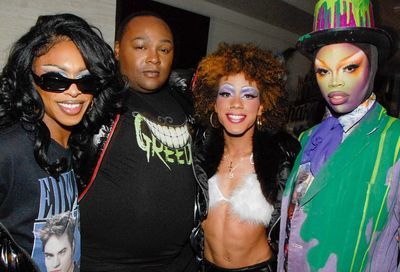Chamber Dance Is The Ultimate Artistic Summer Job
Chamber Dance Project gainfully employs professional musicians and dancers for rare summertime performances.

If you know anything about Chamber Dance Project, it likely has something to do with what motivated the name of the professional dance organization. “The focus of Chamber Dance Project, the reason it even got its title,” says dancer Patric Palkens, “is the marriage between live music and dance.”
The fact is, you can’t have one without the other — or at least you won’t in any program produced by the project. The company’s dancers always perform to live accompaniment, often sharing the stage with musicians. As a result, Palkens says, the music is “part of that live performance. You cut out the music, and you remove a part of the soul.”
Today, many centuries after dancers and musicians originally paired up to invent and perform in tandem the dance genre of ballet for the royal courts of Renaissance Europe, it’s the rare dance company that performs with live musicians. Most opt instead for recorded music, which can be procured at a fraction of the cost.
“Even fairly sizable ballet companies default to canned music,” says Diane Coburn Bruning, founding artistic director of Chamber Dance Project. “I’m not sure how that’s a performing art. If you’re dancing to a recording you’ve heard 95 times, where is the spontaneity? Where is the interaction?”
Bruning launched Chamber Dance Project over two decades ago while living in New York in part as a reaction to the increasing reliance on recorded music.
“For some 20 years, I have been needling the profession: Why are we not embracing live music? I don’t agree with the answer that it’s not affordable. It’s not affordable to put a performing art on stage that is not performed [fully] live? To me, that’s artistically compromised at best.”
Ultimately, performing to live music is only the most obvious of several notable factors that spurred on Bruning with Chamber Dance Project. It’s also one of several factors that continue to distinguish the dance company from others near and far today.
Bruning was also motivated to start the project as a way to help dancers, chiefly by addressing their need for more dance work on a year-round basis.
“[Dancers] tend to have contracts that are 34, 36, 38 weeks of work,” she says. The other 12 to 16 weeks amount to an extended, unpaid summer break — and a perennial search for odd jobs and gigs just to make ends meet.
“A lot of them end up on unemployment, at a pittance of what they should earn,” Bruning says. “I was saddened by it. I thought, ‘What a waste.’ Why lose two and a half months [every year]?” Through Chamber Dance, Bruning has been able to help dancers remain employed in the field by hiring them for summertime performances.
“One thing I think she gets little credit for,” says Palkens, a principal dancer with Atlanta Ballet who also freelances for other companies, “is creating a project specifically when most of us dancers in classical companies in the United States are out of work, either the very beginning of January, when everybody’s off [after] their Nutcracker break, or in the summer, when all of the companies shut down and there’s this whole industry’s worth of ballet-trained, high-performing dancers who are just out of work. And everybody has to scatter to the winds to find projects.”

Palkens has been dancing with Chamber Dance Project for the past few years. In that time he’s learned a lot more than simply new dance moves. He’s helped to fine-tune new work through interaction with fledgling choreographers as commissioned by the company. “[Chamber Dance] so committed to new work, to creating dance, [that] instead of just showing up and being told, ‘Here are your steps, this is what you do,’ you show up and you are a part of the process, and you create new ballets and you work with choreographers.”
Bruning has gravitated toward the new when pursuing artistic collaborators. This has led to new works, pointing the way to new genres beyond the typical work of dance theater.
“At this point in my career — and I don’t mean this offhandedly — I don’t have anything to lose,” says Bruning. “So why play it safe? Why not bring in [a] brass band, put them on stage and say, ‘Here’s a choreographer and we’re going to work together?'”
Bruning helmed the creation of a dance inspired by and featuring singers performing Gregorian chant — a work that Palkens helped originate a few seasons ago and will reprise this year as part of the company’s annual summer programming next weekend.
Chant is one among seven works that will be performed in two distinct programs, a diverse mix of works from six choreographers and featuring a total of 11 musicians, two poets, and 10 dancers. The lineup includes two premieres alongside favorite works from previous seasons, a subtle nod to the 10th anniversary of when Bruning relaunched the company in D.C.
Titled SLAM! A Festival of Ballets, the program includes the newest, unprecedented collaboration SLAM!, a work that will be performed in both programs.
“I’ve been working on the concept with two fabulous slam poets, Gayle Danley and Drew Anderson,” Bruning says. Rather than music performed by a string quartet, the live element propelling the dancers forward in SLAM! is spoken-word poetry, performed live by the poets, also on stage.
Presented in four sections, SLAM! features the work of four choreographers, one per section. All of it, says Bruning, is “put together as a collage, and then we give it a whirl — give it out to the audience and see what happens.”
SLAM! A Festival of Ballets is Thursday, June 22, through Sunday, June 25 at American University’s Greenberg Theatre, 4200 Wisconsin Ave. NW. Tickets are $110 to $125. Visit www.ChamberDance.org.
Support Metro Weekly’s Journalism
These are challenging times for news organizations. And yet it’s crucial we stay active and provide vital resources and information to both our local readers and the world. So won’t you please take a moment and consider supporting Metro Weekly with a membership? For as little as $5 a month, you can help ensure Metro Weekly magazine and MetroWeekly.com remain free, viable resources as we provide the best, most diverse, culturally-resonant LGBTQ coverage in both the D.C. region and around the world. Memberships come with exclusive perks and discounts, your own personal digital delivery of each week’s magazine (and an archive), access to our Member's Lounge when it launches this fall, and exclusive members-only items like Metro Weekly Membership Mugs and Tote Bags! Check out all our membership levels here and please join us today!
























